M c M A S T E R
U N I V E R S I T Y ![]()
McMASTER INVENTORS
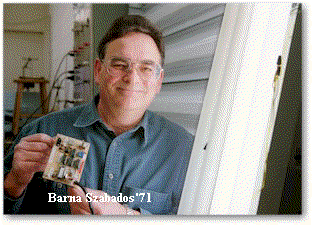
Stories by David Leeder '97
Shedding New Light
Dr. Barna Szabados '71 thought it was inevitable his name would be added to a long list of
engineers who had failed to solve one of science's most baffling problems.
Dr. Szabados had spent four years trying to discover a method of
dimming fluorescent light bulbs - a simple -sounding problem that had dumbfounded everyone
who had tackled it. Close to 60 trials had resulted in little more than a spree of
laboratory fires and disappointments for Szabados, an electrical & computer
engineering professor and the director of the Power Research Laboratory at McMaster. He
and his trio of associates could no longer afford to invest their own savings in the
pursuit.
Then, after another in a string of sleepless nights, on Nov. 17, 1998
(he still remembers the exact date), he took one last figurative stab in the dark. He saw
the light.
"We considered walking away quite often," he remembers.
"We spent close to a million dollars to get that (project) going. We were running out
of funds. We kept asking ourselves, `Can we really keep pitching in the funds without
getting a
solution?
Traditional incandescent light bulbs can be dimmed simply by reducing
the heat to the filament. But fluorescent light bulbs are much different. When the
filament heats up, electrons are released into the tube and collide with atoms to produce
light. When the voltage is decreased, an insufficient number of electrons are released to
create light.
A solution to that problem had stumped everyone for 40 years. In the
past, scientists tried to modify the current once it was inside the bulb in order to
change the output. A strobe -light effect was the closest anyone came.
Szabados reversed the process. His solution involves modifying the current's size and
shape before it enters the tube. The process also eliminates the annoying buzzing noises
and flickering of the tubes.
"It took us from November until June to have that success under
control," he admits. "We were using normal heat sinks all along. We had them
heating up, but, if we didn't have a breakthrough to cool them, we didn't have a product.
"It was nice to have a process that worked, but the discovery
doesn't always lead to a product. We had to work almost as hard to put into effect our
discovery."
In Toronto alone, there are almost 10 million fluorescent fixtures in
use. Many run 24 hours a day. According to Szabados' estimates, if 50 per cent of those
lights were dimmed, enough power would be saved to close two of Ontario's coal -fired
generating plants.
Even during the day, power can be reduced by as much as 35 per cent by
slight dimming without any visible difference in illumination.
Last summer, the group wired a downtown Hamilton office building with
the new technology. They hoped to save the company 50 per cent on its energy bill based on
their lab estimates. Instead, that figure jumped as high as 78 per cent.
It seems like an environment and economic windfall. But the blunders of
past "breakthroughs" hindered his group. After obtaining a patent, they couldn't
find investors willing to overlook the near -misses and broken promises of past groups.
That is, until a story aired on the Discovery Channel's flagship news
program, @Discovery.ca, on Feb. 3. Shrewd producers had documented the experiment for over
two years prior to the invention. The piece also mentioned the group's difficulties in
marketing their find.
"Now we have problems pushing them away," says Szabados, who
proudly tells stories of alumni offering to sell shares in the product to all past
graduates and of students suggesting the money could go along toward alleviating the
student body's financial burdens.
Recently, potential investors thought they could "bully
around" the group into selling their invention. With several firm offers on the table
and others expected, Szabados admits giving investors a dose of their own medicine.
"Now, with publicity, we can out -muscle them," he says.
"I was telling my wife, `It really is amazing, the power of publicity.'"
He really has seen the light.
Brain Power
Dr. Jeff Galef thinks few animals are cuter than a baby rat. Over the past 30 years, he's
developed an "odd" affinity for the rodent. After all, Dr. Galef, a psychology
professor at McMaster, has spent most of his professional life study -ing the social
behaviour and interactions of a creature that makes most of us cringe.
"They're really very intelligent," he says. "They've
thrived as a result of contact with others. It's really quite spectacular, in fact, that
an animal can outwit human beings for hundreds of years."
But they couldn't outwit him.
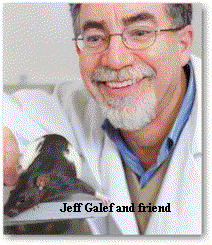
Dr. Galef may have learned to love them. He's also developed a
foolproof way to kill them.
He has spent the last several years examining the chemical
communication system that rats use to survive. If a rat comes across a new and appealing
flavour, such as cocoa, it will learn from others whether this flavour is safe to eat.
That is, if a rat sniffs another rat and smells cocoa, it will readily eat cocoa
-flavoured food, even if it has never encountered such food before.
Social interactions do not allow rats to learn what foods to avoid. If
a sick rat has cocoa -flavored breath, a social partner will not avoid cocoa -flavored
food. Normally, a rat will eat only a small amount of an unknown food or poison, become
sick and then avoid it.
In his research, Galef discovered the internal chemical that allows
rats to signal to each other that a food is safe to eat.
That discovery uncovered the ultimate rodenticide.
Galef was able to deduce that, by combining food, poison, and a
quantity of that chemical, rats would be unable to identify that an unfamiliar substance
is actually a poison. It would be too late before they discovered their mistake.
Finally, he thought, there was a solution for centuries of blunders by
human beings who fought futilely to combat the rodents, all the while actually providing
them more food and shelter. In many countries, including India and China, rats eat close
to 40 per cent of all food produced. It's an epidemic that Galef thought he'd found the
miracle solution to. That is, until he sought investors with patent in hand in 1989.
"It was very exciting at first," he remembers. "We were
speaking with some of the world's largest chemical companies. They were all interested.
When push came to shove, however, it didn't pan out."
Galef received a $20,000 offer from one of the world's most prominent
chemical multinationals. His lawyers told him to hold out for more. He's still waiting.
"I'm a basic researcher. I'm content with that. Except for the
castles in Spain - the dreams of grandeur - I didn't devote my life to this finding."
He concludes with a chuckle, "That's probably lucky, because, for
some reason, it didn't get very far."
Smart Togs
It is hard to distinguish Dr. Steve Mann '87 from a robot these days, in appearance or
ability.
He's got a computer hard drive, miniature keyboard and radio
equipment attached to his back and chest. Sensors monitor his body temperature,
breathing, heart rate and his movement. He's always wearing a pair of thick,
black sunglasses, which allow him to see the real world while also hiding a
tiny camera lens which allows him to see the World Wide Web. And he lugs around
enough rechargeable batteries to power his "cybersuit" each day.
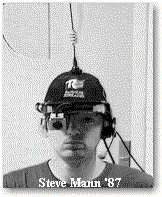
A human being? Or a cyborg? It's hard to tell.
Dr. Mann is the inventor of WearComp, a wearable computer, and WearCam,
a camera and reality mediator that looks like a simple pair of sunglasses.
His cyberclothes may look lumpy, uncomfortable, and even awkward. But
they do have a purpose. They provide the services of a cellular phone, pager, Walkman,
dictation device, camcorder, laptop computer, microphone and more. He's a walking,
wireless morphing of man and machine.
Don't think these odd contraptions don't have functional, everyday uses
as well.
While Mann was a graduate student at the Massachusetts Institute of
Technology, the thermostat in his apartment broke. He simply replaced it with a radio
receiver to pick up signals from his underwear. When he got cold, sensors turned the heat
up.
When he's grocery shopping, his wife, Betty, can send him a message,
seen visually, to pick up a loaf of bread.
Mann has been working on his Wear -Comp invention for more than 20
years, since his high school days in Hamilton in the 1970s. It began as an interest in
body -worn computing coupled with wireless com -munications. He was trying to control and
sequence body -worn light sources, such as electronic flashes, in order to create visual
art through a camera system. It all started from a collection of broken walkie -talkies.
After graduating from McMaster, Mann went on to introduce his
"smart" clothing to MIT, where he established the highly publicized Wearable
Computing Project and earned his doctorate in the new field.
At one point, between 1994 and '96, he invited the world to click on
his internet site and view a continuously transmitting documentary of his life. You could
watch him eat breakfast, then ride the subway to
school and sit in on a lecture with him. Close to 30,000 Web surfers visited the site each
day, clogging the system and causing all the computers in Mann's MIT building to crash,
preemptively causing the cancellation of the experiment.
Mann is now at the University of Toronto, where he is an assistant
professor of computer and electrical engineering.
This use of technology is a glimpse into our future, says Mann.
"Over an extended period of time, the wearable computer begins to
function as a true extension of the mind and body, and no longer feels as if it is a
separate entity. In fact, the user will often adapt to the apparatus to such a degree
that, when taking it off, its absence will feel uncomfortable."
Hot Idea
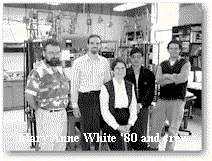
Dr. Mary Anne White '80, considered one of Canada's most influential scientists, isn't
embarrassed to admit a putrid secret about herself. She loves the smell of stinky, sweaty
feet.
With her collaborators, Dr. White, who graduated from McMaster with her
PhD in chemistry and is now the Killam Research Professor in Materials Science and
professor of chemistry and physics at Dalhousie University, has developed a new class of
chemicals which absorb waste heat from industrial processes and can also be used to
insulate homes.
Basic science tells us that if a material is heated, its heat content
increases. If it melts, extra heat will be required to do so. White, who specializes in
the thermal properties of materials, deduced that this added heat can be recovered and
used later.
Her "new" chemicals stay in a solid form. They don't melt or
float away when they gain or lose heat, a problem faced by others in the past. Fluffy, but
waxy, in texture, they resemble large flakes of soap. But it's the odour that strikes most
right away.
"I absolutely love that smell," she says with a chuckle.
"It smells like success."
After more than seven long, sometimes frustrating, years, White finally
overcame impediments in the project in the last three years. She and her colleagues are
now testing the energy -efficient material, designed with special heat -storage
properties, in a solar home in the Halifax area. The materials will be heated up during
the day by solar energy and then radiate the stored heat at night.
"We had the idea that it could be made. We actually made
them," says White. "Now, the dream would be to see our
material in the market place - to see it used everywhere."
Super Model
Even Dr. Fred Hoppe was nonchalant about a short piece of work he published in 1984.
He thought it was simply a reaction to a paper on population genetics
he didn't understand. Dr. Hoppe was just trying to refute a colleague's work. Instead,
that four -page paper has become one of the great achievements in his career and helped
advance research on the topic.
"That work almost never saw the light of day," he says.
"Even to this day, people are coming up to me all the time and wanting to discuss it
with me."
That very short paper, published in the Journal of Mathematical
Biology, introduced what is now referred to as the Hoppe Urn Model. The goal
of the model is to find out how long in the past a common ancestry existed and
to determine the forces leading to the genetic structure of populations.
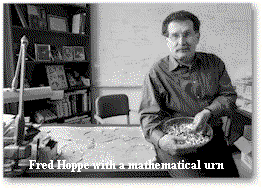
Urn models are often used in population genetics as a metaphor, or
mathematical abstraction, for how alleles - different flavours of genes - are passed from
generation to generation in a population of bacteria, zebras, or people. A mathematical
urn is represented by a container with various numbers of balls of different types (or
colours). For example, the blind selection of different coloured balls from the urn can be
compared to the random inheritance of eye colour, or the tendency to develop certain
genetic diseases. Over the past two centuries, the metaphor has been
greatly extended to explain some of the more subtle points of population genetics. Hoppe's
contribution to urn theory introduced a new way of explaining not just how existing
alleles - for example, blue eyes or brown eyes - are passed from parent to child, but how
completely new
alleles - say, purple eyes - that appear in a population are passed down.
"Some papers you write simply sit in-house, gathering dust,"
Hoppe, a professor in the Department of Mathematics & Statistics, says.
"Sometimes you see something very, very nice. That was one of those. It was
surprising to see something so simple. It's the pinnacle of a designer. Lawyers try to
make simple things complicated. We try to do the opposite."
He confides that the initial paper didn't take excessive amounts of
time or energy, unlike most projects he tackles. It brought, however, one of the most
satisfying discoveries of his career.
"I just couldn't understand the argument at all," he says.
"So I tried to look at it another way.
"You're curious. You're stubborn. It's like finding a nugget of
gold in iron ore."
![]()
| Return to McMaster Times Homepage | Return to M c M A S T E R H O M E P A G E |